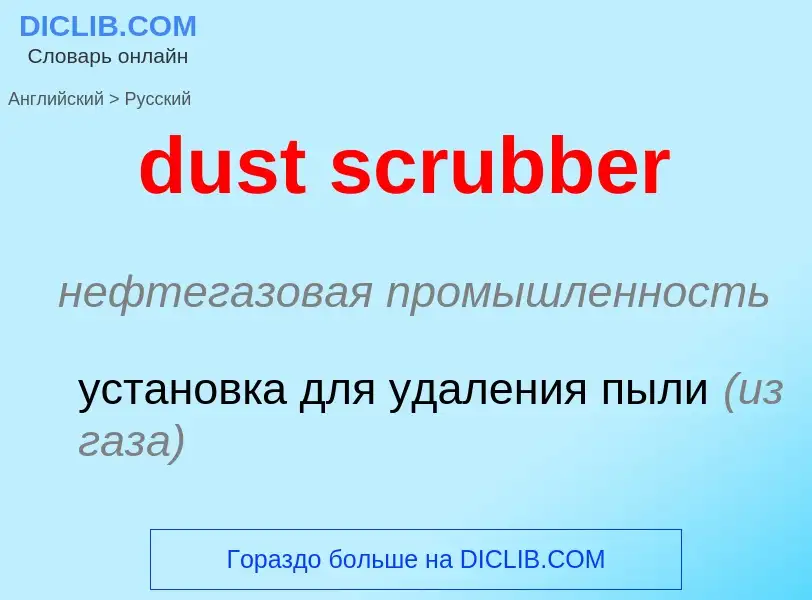Vertaling en analyse van woorden door kunstmatige intelligentie ChatGPT
Op deze pagina kunt u een gedetailleerde analyse krijgen van een woord of zin, geproduceerd met behulp van de beste kunstmatige intelligentietechnologie tot nu toe:
- hoe het woord wordt gebruikt
- gebruiksfrequentie
- het wordt vaker gebruikt in mondelinge of schriftelijke toespraken
- opties voor woordvertaling
- Gebruiksvoorbeelden (meerdere zinnen met vertaling)
- etymologie
dust scrubber - vertaling naar russisch
нефтегазовая промышленность
установка для удаления пыли (из газа)
общая лексика
космическая пыль
Definitie
Wikipedia

Cyclonic spray scrubbers are an air pollution control technology. They use the features of both the dry cyclone and the spray chamber to remove pollutants from gas streams.
Generally, the inlet gas enters the chamber tangentially, swirls through the chamber in a corkscrew motion, and exits. At the same time, liquid is sprayed inside the chamber. As the gas swirls around the chamber, pollutants are removed when they impact on liquid droplets, are thrown to the walls, and washed back down and out.
Cyclonic scrubbers are generally low- to medium-energy devices, with pressure drops of 4 to 25 cm (1.5 to 10 in) of water. Commercially available designs include the irrigated cyclone scrubber and the cyclonic spray scrubber.
In the irrigated cyclone (Figure 1), the inlet gas enters near the top of the scrubber into the water sprays. The gas is forced to swirl downward, then change directions, and return upward in a tighter spiral. The liquid droplets produced capture the pollutants, are eventually thrown to the side walls, and carried out of the collector. The "cleaned" gas leaves through the top of the chamber.
The cyclonic spray scrubber (Figure 2) forces the inlet gas up through the chamber from a bottom tangential entry. Liquid sprayed from nozzles on a center post (manifold) is directed toward the chamber walls and through the swirling gas. As in the irrigated cyclone, liquid captures the pollutant, is forced to the walls, and washes out. The "cleaned" gas continues upward, exiting through the straightening vanes at the top of the chamber.
This type of technology is a part of the group of air pollution controls collectively referred to as wet scrubbers.



![Cosmic dust of the [[Andromeda Galaxy]] as revealed in infrared light by the [[Spitzer Space Telescope]]. Cosmic dust of the [[Andromeda Galaxy]] as revealed in infrared light by the [[Spitzer Space Telescope]].](https://commons.wikimedia.org/wiki/Special:FilePath/Andromeda galaxy Ssc2005-20a1.jpg?width=200)


![Cosmic dust of the [[Horsehead Nebula]] as revealed by the [[Hubble Space Telescope]]. Cosmic dust of the [[Horsehead Nebula]] as revealed by the [[Hubble Space Telescope]].](https://commons.wikimedia.org/wiki/Special:FilePath/Horsehead-Hubble.jpg?width=200)



